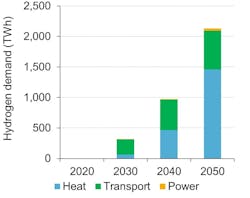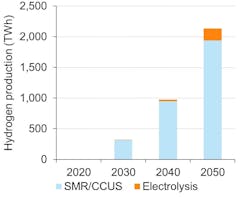Hydrogen by Pipe: Embracing the Fuel of the Future
Fact File: Hydrogen Production Methods
Hydrogen can be produced in a number of ways:
Electrolysis — electricity is used to separate water into hydrogen and oxygen. If the electricity is renewable, the hydrogen is considered zero carbon. This is sometimes called ‘green’ or ‘renewable hydrogen.’
Steam Methane Reformation (SMR) — refers to a chemical synthesis that reacts steam at high pressure to produce hydrogen and carbon dioxide from hydrocarbons such as natural gas. This is sometimes referred to as ‘grey hydrogen.’
SMR with Carbon Capture Utilization and Storage (CCUS) — when CCUS is added to the SMR process to capture and prevent release of the carbon dioxide, the process can be considered as low carbon. This is sometimes referred to as ‘blue hydrogen.’
Thermal Methane Pyrolysis (TMP) — this involves natural gas and a low-temperature, high-pressure reaction with no oxygen present to produce hydrogen and solid carbon. This is also ‘blue hydrogen.’
The energy potential of hydrogen has been discussed since the 1870s. In his novel, The Mysterious Island, the visionary author Jules Verne wrote, “water will one day be employed as fuel, that hydrogen and oxygen which constitute it, used singly or together, will furnish an inexhaustible source of heat and light, of an intensity of which coal is not capable.” Now, almost 150 years later we are starting to realize that maybe he was on to something. It is possible that hydrogen offers a route to the decarbonization of our energy systems and this is becoming increasingly attractive to policy makers and the energy industry for several reasons.
What Are the Benefits of Hydrogen?
Primarily, hydrogen does not emit any carbon when burned and so it could be considered a zero-carbon energy source, depending on how it is produced. It can be used as a replacement for natural gas in many situations, including power generation, industrial feedstocks, process heat, and domestic heat and cooking. It can also be used with fuel cells to decarbonize transport. In short, hydrogen can help decarbonize sectors where a total electrification solution could be extremely difficult and expensive to achieve.
The energy industry has grasped the potential of hydrogen and many projects are underway to investigate its production and use. These projects vary in scale from smaller investigations into standalone electrolyzers, to blending hydrogen with natural gas in existing networks, hydrogen combined cycle gas turbines (CCGTs) and the grand ambitions of the H21 project in the North of England. H21 North of England aims to convert 3.7 million U.K. homes and businesses from natural gas to hydrogen, making it the world’s largest clean energy project. For gas producers and network companies, hydrogen provides a possible answer to the existential threat of an all-electric world. If natural gas can be converted into hydrogen with little or no carbon emissions, then the existing gas networks could be repurposed to deliver hydrogen to provide heat to industry and homes. Hydrogen can also be stored in many of the existing natural gas storage facilities and this could allow a form of seasonal storage that renewables alone cannot provide.
Any discussion of hydrogen as a fuel source raises questions about its safety. Hydrogen is highly flammable and so there are concerns around transporting and storing the gas, especially in a domestic environment. Despite this, hydrogen disperses more quickly so it is unlikely to cause breathing hazards or collect where it can combust. Hydrogen Europe states that the fuel is as safe as other flammable fuels like gasoline and natural gas, but public perception of the fuel could disrupt its roll-out on a mass scale.
For the industry, hydrogen offers a route to decarbonization that otherwise could be extremely costly and difficult. It offers an alternative to electrification — which for some may not even be feasible — and an alternative to the installation of carbon capture at individual plants. Green or blue hydrogen can also decarbonize many industrial feedstocks like ammonia production, and demonstration projects are investigating how hydrogen could decarbonize steel production. Converting power to hydrogen allows excess renewable electricity to be used, adding value and creating further revenue for renewables and avoiding curtailment of surplus energy. It also raises the possibility of using hydrogen as a storage medium for electricity. Excess electricity can be used to create hydrogen at times of low demand or price, which can then be stored and converted back into electricity when demand or price increases.
So, What’s the Issue?
It seems hydrogen could solve all our energy problems! In reality, there are many issues that need to be considered before starting to deploy hydrogen as a fuel-source. Firstly, the hydrogen supply chain will need to be significantly expanded to meet potential demand, including production, transport, and storage. Unfortunately, there are significant risks to this expansion as there is no certainty that the demand will follow.
Secondly, there are issues with each of the hydrogen production methods. Grey hydrogen is not low carbon and so has little role to play in a decarbonized energy environment. Blue hydrogen needs carbon capture and storage (CCS), and although this is a proven technology, we are not yet at a stage where it can be deployed economically at scale. Green hydrogen involves the most expensive of the production methods and will require very low electricity prices and reductions in the costs of electrolysis to make it a reality. Pyrolysis is not yet proven to be a scalable solution that is competitive with the other production methods. Despite this, if hydrogen is the solution to decarbonizing the difficult sectors of residential heat, industrial heat, and the heavier end of the transport sector, then these issues will need to be overcome. Pöyry’s study ‘Decarbonizing Europe’s Energy System by 2050’ compared a zero-carbon gas pathway with an all-electric pathway and examined the potential role for hydrogen for the heat, power, and transport sectors. In the zero-carbon gas pathway, hydrogen demand is expected to grow significantly in these three sectors to reach over 2000 TWh by 2050. Looking at different production costs of hydrogen, the study found that hydrogen production costs from methane reformation were consistently lower than hydrogen produced by electrolysis.
This is because by 2050 a flexible demand side made possible by millions of electric vehicles (EVs), and high levels of interconnection, mean that there is generally an absence of many very low electricity price periods, which otherwise would support hydrogen production from electrolysis at lower cost than from methane reformation. Subsequently methane reformation is the dominant source of hydrogen production. However, production from electrolysis has a higher share in some regions in Europe with very high renewable penetrations and less system flexibility.
Figure 1 shows the potential growth in hydrogen demand by sector to 2050 from our zero-carbon gas pathway. It depicts how the heat and transport sectors could drive this demand growth. Figure 2 shows the relative split of hydrogen production between SMR/CCUS and electrolysis in the same pathway.
What is the Future of Hydrogen in the Energy Mix?
The potential of hydrogen is clear, but the route to realizing this potential is uncertain. There are numerous barriers that will need to be overcome which include creating a business case, acceptance of CCS, public acceptance of hydrogen at home as well as proving how safe hydrogen is. If these barriers can be overcome, then it could be possible for us to exploit Jules Verne’s ‘inexhaustible supply of heat and light’.




